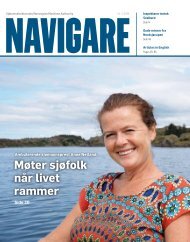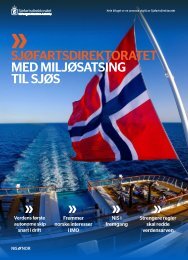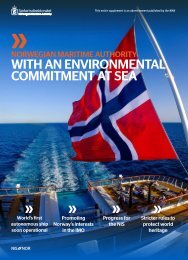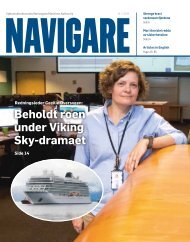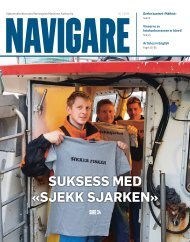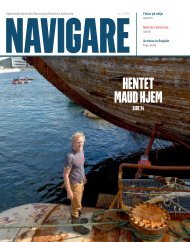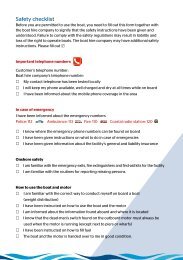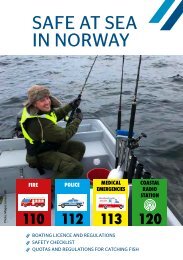Create successful ePaper yourself
Turn your PDF publications into a flip-book with our unique Google optimized e-Paper software.
NEWS
ENGLISH TRANSLATION FROM PAGE 8
by the memory of those that could not be
saved.
HYPOTHERMIA
On board the ferry there was nobody on
deck. Two men were out in a dinghy
searching for survivors, the rest of the crew
was on the bridge manoeuvring the ferry.
He assumes that approximately half an
hour had passed since he jumped into the sea
from the sinking ‘Sleipner’, and he was
freezing. He was shaking and trembling with
cold. His body temperature was ominously
low.
‘I and the other guy who had been saved
on board the ferry went below deck to find a
crew cabin each. There, I found a couple of
duvets, socks and a boiler suit and tried to
warm up again under the duvets.’
He was well familiar with the layout of the
HSD ferries from his year as a seaman and
ticket collector on several ferries in the
Sunnhordland basin.
About an hour later he had warmed up a
little, so he went upstairs to the mess hall.
The TV was on, and the nine o’clock news
had just started, bringing updates on the
drama that was unfolding around him.
GOING HOME
The MF ‘Strandebarm’ continued to search
for survivors for some time before heading to
Langevåg on Bømlo island. Here, a reception
centre had been set up for survivors who had
been brought to shore by the ferry, the
‘Espeværekspressen’ speedboat and the taxi
boat ‘Sjøfart’ from Røvær.
Erik J. Landa was one of the 33 who came
ashore at south Bømlo, where ambulances and
many relatives were waiting. Erik did not need
medical attention, and once the police had
registered him as a survivor he was ready to
continue home to Stord by bus, via the
Siggjarvåg-Sagvåg ferry connection.
‘I came home at around two in the
morning. It felt good to come home to my
wife and three children – they were both
overjoyed and relieved. Those who sat there
at home waiting probably had it worst. After
all, I had had my hands full, focusing on
staying alive,’ says the realist Erik J. Landa,
who concludes:
‘I had a huge amount of luck. If I hadn’t
ended up in that life raft, I don’t know how it
might have ended,’ he says pensively.
IN THE BACK OF HIS HEAD
The weekend was spent with his family,
talking through what had happened. There
were many questions, from his wife and
children, but also from his father who had
worked in the HSD ferry company for nearly
all his life, as a captain on the early hydrofoil
boats and later on the westamarans. Never on
the shipwrecked ‘Sleipner’, though.
‘I took Monday off from work and went
back to Flekkefjord on Tuesday, on
‘Sleipner’s’ sister vessel ‘Draupner’. I thought
I’d better get back to work, rather than sit at
home brooding. I was offered a psychologist,
but I chose to spend time with those at home
to let things normalise again. I try to put the
tragedy behind me, and it has gone well so
far, with no after-effects. However, it’s still
there in the back of my head,’ Erik Landa
admits.
Erik Johan Landa was never in doubt
about what occupation to choose. It had to be
the same as that of his father: sea captain, or
«The ‘Sleipner’
accident motivated
me to work with
maritime safety.»
skipper, as it is also called. It was only
towards the end of his career that he started
to aim for a job in the Norwegian Maritime
Authority. At that time, he also had his own
experience of the ‘Sleipner’ accident on his
mind.
‘Yes, the accident was surely a
contributory factor for me to consider several
times applying for a job in the Norwegian
Maritime Authority. However, it didn’t come
about until 2014,’ he tells us.
At the time, Landa was working in
Dubai, where he had spent three years
monitoring the construction of six seismic
vessels that the Polarcus DMCC company
had under construction there. His wife Heidi
had joined him in Dubai for a period when she
was offered a new job on Stord island.
‘I was in the application process for a job in
the Norwegian Maritime Directorate, had been
for an interview, and I thought that now it
could be my wife’s turn to have the job she
really wanted. Until then, my job preferences
had been prioritised, so now her turn had
come,’ says Erik. His wife got the job on
Stord, he got the job in Haugesund and
became a commuter.
FROM SEAMAN TO CAPTAIN
He had started his career in his late teens in
the HSD shipping company as a deck hand
and junior seaman on the cargo vessel
‘Halsnøy’ and later as a seaman and ticket
collector on several of the HSD ferries that
plied the Sunnhordland fjords.
Later he attended navigation school and
went into ocean transport as second and first
mate before enrolling for two years in maritime
college in Bergen. Next came five years in the
Johan Ludwig Mowinckel shipping company,
followed by the Royal Norwegian Navy where
he served for five years as second in command
and vessel commander in the Coast Guard.
Later came Geco, Rieber Shipping and finally
Polarcus, before he joined the Norwegian
Maritime authority as a senior surveyor.
‘I applied for the job because of my wish to
perhaps help make some contribution to
safety. This was a good opportunity to share
my experiences and state my views. I know
that many things can go wrong, and these
small margins are exactly the reason why the
safety standards must be strict,’ Landa states.
WORKING ON NEW CONSTRUCTIONS
His job in the directorate is to be project
director for new construction in the passenger
vessel department. Part of his responsibility is
to ensure that the navigation and safety
equipment comply with the applicable
regulations.
In addition to his experience from a
number of safety training courses and drills
undertaken during his years at sea, he is now
engaged in testing life rafts, vests and life
boats. For example, since 2016 he has been
actively involved in annual tests of rescue
equipment in Svalbard as part of the SAREX
56 | Navigare 4 - 2019









